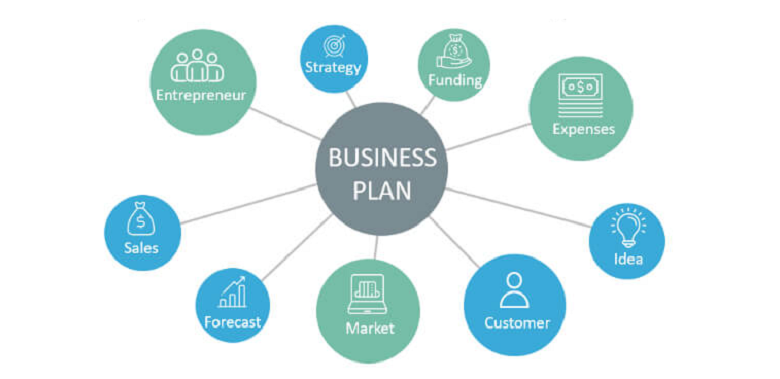
Every entrepreneur understands the importance of a solid business plan, but not all grasp the crucial role of financial projections within that blueprint. Financial projections aren’t just about appeasing investors or lenders; they’re about charting a realistic and sustainable course for your business’s future. They offer a window into the anticipated financial health of your enterprise, guiding decisions and flagging potential challenges. Here we navigate the intricacies of crafting a comprehensive financial projection, illuminating the steps to ensure your business’s financial clarity and readiness.
Contents
- Introduction to Financial Projections
- Understanding the Basics of a Financial Projection
- Steps to Create a Financial Projection
- Tips for Creating Accurate Financial Projections
- References
Introduction to Financial Projections
In the realm of business planning, there’s a phrase that often circulates: “If you fail to plan, you plan to fail.” While many aspects of a business plan are crucial, understanding and projecting your business’s financial future might be one of the most pivotal. These projections can serve multiple purposes, from seeking funding to ensuring your business remains on a growth trajectory.
Definition of a Financial Projection
So, what exactly is a financial projection? At its core, a financial projection is a forecast of your business’s future financial performance. It’s a prediction of revenues, expenses, and profitability based on past data, current market conditions, and expected future trends. Imagine it as a roadmap for where you expect your business’s finances to be in the upcoming months and years.
Importance of Financial Projections in Business Planning
Underestimating the significance of financial projections is a common pitfall. These aren’t mere numbers on a sheet; they are a visualization of your business’s heartbeat. Financial projections:
Garner Investor Trust
For investors, your financial projection provides a glimpse into your business acumen, illustrating if you’ve done your homework and are aware of potential challenges ahead.
Secure Loans
When approaching lenders, they’ll want to be assured of your business’s capability to repay. Your projections offer this assurance, showing your anticipated income and expenses [1].
Guide Internal Decision Making
For your internal team, these figures act as a lighthouse, ensuring that your business stays on course. They can help identify potential cash flow issues, guide pricing strategies, and determine potential areas of investment or cost-cutting.

Understanding the Basics of a Financial Projection
Before getting into creating your financial projections, it’s essential to grasp some foundational concepts. By understanding the primary components and the typical time frames involved, you’re better positioned to tailor your projections to your business’s unique needs and situations.
Key Components of Financial Projections
Every business, regardless of its size or industry, has some standard financial components that need to be factored into projections. While the depth and complexity may vary, the core elements remain consistent.
Revenue Forecast
The revenue forecast is a prediction of the sales and income your business expects to generate over a particular period. This isn’t just a ballpark figure but should be based on tangible data like historical sales, current orders, and market trends.
Expense Budget
This encapsulates all the costs your business is likely to incur. From salaries and rent to marketing expenses and utilities, an expense budget provides a comprehensive view of where your money will be going. It’s crucial for ensuring profitability and identifying areas where cost-efficiency can be improved.
Cash Flow Statement
Arguably one of the most critical components, the cash flow statement provides insights into how cash moves in and out of your business. It ensures that your business remains liquid, can pay its bills, and can invest in growth opportunities when they arise.
Profit and Loss Statement
Often referred to as the income statement, this document gives an overview of your business’s profitability over time. It considers both revenues (income) and expenses to determine if the business is making a profit or incurring a loss.
Balance Sheet
Acting as a snapshot of your business’s financial health at a particular point in time, the balance sheet outlines your assets (what the company owns), liabilities (what the company owes), and equity (the owner’s or shareholders’ stake in the company) [2].
Time Period for Projections
Financial projections aren’t a one-size-fits-all endeavor. Depending on your business goals, the nature of your industry, and specific needs, the projection period can vary. Generally, these projections can be categorized into short, medium, and long-term.
Short-term (1 Year)
These projections provide a granular view of the business’s financial path in the immediate future. Especially beneficial for startups or businesses undergoing significant changes, short-term projections often have monthly or quarterly breakdowns.
Medium-term (3-5 Years)
Taking a broader perspective, medium-term projections are essential for businesses looking to expand, introduce new products, or enter new markets. They offer a more extended glimpse into the business’s financial health, enabling strategic planning and long-term decision-making.
Long-term (5+ Years)
For established businesses or those in industries with lengthy product development cycles, long-term projections can be invaluable. These offer a panoramic view of the business’s trajectory, helping to shape large-scale investments, mergers, or other significant financial decisions.

Steps to Create a Financial Projection
Crafting a financial projection might seem daunting, especially if you’re diving into it for the first time. However, with a systematic approach, it becomes a manageable task, allowing you to translate your business vision into numerical realities.
Gather Historical Data
Starting with a review of your business’s past performance provides a foundation upon which future projections can be built. Historical data not only offers a perspective of where you’ve been but can help in predicting future trends.
Previous Sales Figures
Begin with a thorough analysis of your past sales data. This can include monthly sales, seasonal fluctuations, and year-on-year growth. If your business is new and lacks historical sales data, consider analyzing competitors or similar businesses in your industry.
Past Operating Expenses
Scrutinize previous costs, identifying any patterns. Did marketing expenses peak at a particular time of the year? Were there unexpected costs that recurred? Recognizing these trends can guide your projections.
Capital Expenditures and Investments
Review past investments, including machinery, property, or other significant purchases. Understand their depreciation and how they influenced your financial position.
Estimate Future Revenues
With historical data in hand, you can now start forecasting future income. This requires a mix of analysis, market understanding, and sometimes, a bit of educated guesswork [3].
Analyzing Market Trends
Stay abreast of market developments, sector growth, and broader economic indicators. For instance, if there’s a growing demand for eco-friendly products and your business is in that niche, you can anticipate higher sales.
Factoring in Business Growth and Expansion
Consider any expansion plans, be it opening a new store, launching a new product line, or tapping into a new market segment. These ventures will likely impact your revenue streams.
Considering Economic Factors
External factors like inflation, economic downturns, or changes in regulatory environments can all affect your business revenues. It’s crucial to factor these into your revenue projections.
Forecast Operating Expenses
Understanding your future costs is just as vital as predicting revenues. A business might have skyrocketing sales, but if expenses aren’t managed, it could still operate at a loss.
Fixed Costs
Start with costs that remain relatively constant, such as rent, salaries, and utilities. These are predictable and can be easily factored into your projections.
Variable Costs
These expenses fluctuate based on business activity. For instance, if you produce more goods, your raw material costs might increase. Forecasting variable costs requires a good understanding of your business operations.
Unexpected Expenses
While we can’t predict all unexpected costs, having a contingency or emergency fund is prudent. This can cover unexpected repairs, legal fees, or other unforeseen expenditures.
Project the Cash Flow
The lifeblood of any business, cash flow ensures you can meet your financial obligations, from paying suppliers to covering payroll.
Expected Incoming Cash
Factor in all sources of incoming cash, not just sales. This can include loans, investments, or any other influx of funds.
Expected Outgoing Cash
Look at all anticipated expenses, both regular and one-off payments. This could range from monthly utility bills to yearly tax payments [4].
Ensuring Positive Cash Flow
It’s essential that the cash coming into the business is more than what’s going out. Consistently negative cash flow can lead to insolvency.
Compile Profit and Loss Statement
Now, with both projected revenues and expenses at your disposal, you can determine your business’s potential profitability.
Estimating Gross Profit
Deduct the cost of goods sold (COGS) from your total revenue to get the gross profit. This gives an initial glimpse into the business’s profitability without factoring in other operational costs.
Factoring in Operational Costs
Subtract all operational expenses (both fixed and variable) from your gross profit. This will provide an accurate picture of your net operational profit.
Predicting Net Profit
After deducting any additional expenses or obligations, like taxes or loan repayments, you will arrive at the net profit. This is the true bottom line, indicating the health and profitability of your business.
Design the Balance Sheet
A balance sheet provides a comprehensive snapshot of your business’s financial standing at a specific point in time.
Current Assets and Liabilities
List all short-term assets (like cash or inventory) and liabilities (like short-term loans or accounts payable).
Long-term Assets and Liabilities
Include assets that are expected to provide value over a longer period, like machinery or property. Similarly, factor in long-term debts or obligations.
Owner’s Equity
This represents the owner’s stake in the business. It’s derived by subtracting total liabilities from total assets.

Tips for Creating Accurate Financial Projections
Drafting a financial projection is both an art and a science. While the steps outlined above provide a structured approach, there are certain nuances and best practices that can make the difference between a generic forecast and a truly insightful financial projection.
Stay Conservative in Your Estimates
It’s natural to be optimistic about your business’s prospects, especially if you’re passionate about your venture. However, when it comes to financial forecasting, it’s wise to err on the side of caution [5].
Avoid Overestimating Sales
While it’s tempting to predict a steep upward trend, it’s more prudent to take a conservative stance. This doesn’t mean underselling your business but rather being realistic in your predictions.
Plan for Worst-Case Scenarios
Always have a contingency plan. Whether it’s an economic downturn, unexpected expenses, or a key deal falling through, your projection should be resilient enough to weather such challenges.
Regularly Update Projections
The business environment is dynamic, and what might seem like a sure thing today can change tomorrow. Thus, it’s essential to keep your projections updated.
Factor in New Data
As you gather more data on sales, expenses, and market trends, continuously refine your projections to reflect this new information.
Adjust for External Changes
Economic fluctuations, regulatory changes, or even global events can impact business operations. Stay informed and adjust your projections accordingly.
Seek Expertise When Needed
While as a business owner you know your enterprise inside and out, there’s no harm in seeking external expertise, especially when it comes to financial planning.
Hire or Consult a Financial Expert
A seasoned financial expert can bring a fresh perspective, spot potential pitfalls, and even suggest strategies you hadn’t considered.
Utilize Financial Software
Modern financial software tools come equipped with features that can automate parts of the projection process, provide templates, and even offer predictive analytics.
Validate Assumptions
Every projection is based on a set of assumptions. While some assumptions are based on hard data, others might be based on market insights or trends.
List Assumptions Explicitly
By clearly stating the assumptions on which your projections are based, you make them transparent for stakeholders and easier for yourself to revisit.
Regularly Review and Challenge Assumptions
Don’t let your assumptions become set in stone. As the business landscape evolves, revisit these assumptions, challenge them, and refine as needed.
Ensure Consistency
Consistency in how you approach, structure, and revise your financial projections ensures that they remain reliable and easy to understand.
Stick to a Format
Whether it’s the categories you use, the time frames you consider, or even the software tools you deploy, maintaining consistency makes it easier to track changes, spot trends, and make comparisons.
Cross-Check for Discrepancies
Ensure that your financial projections align with other aspects of your business plan. For example, if you’re predicting a steep rise in sales, your marketing and operations plans should reflect strategies to drive and accommodate that growth.
References
[1] 6 steps to making financial projections for your new business
[2] Writing a Business Plan—Financial Projections
[3] What are Financial Projections and Why Do You Need Them?
[4] How to Create a Financial Forecast for a Startup Business Plan
[5] Business Plan – Financial Projections Section
